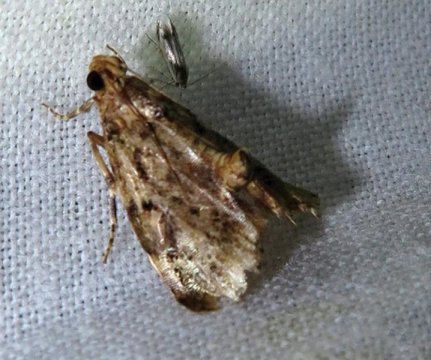New members have joined the ranks of the snout moths -- one of the largest groups within the insect order known formally as Lepidoptera, comprising all moths and butterflies.

The newly discovered snout moth species Androconia rallusa shown in resting position.Credit: Mingqiang Wang
Recently, taxonomists Dr. Mingqiang Wang, Dr. Fuqiang Chen, Prof. Chaodong Zhu and Prof. Chunsheng Wu of the Institute of Zoology at the Chinese Academy of Sciences described two genera and three species previously unknown to science discovered in southern China.
Their study is published in the open access journal ZooKeys.
Having named one of the two new genera Androconia, the scientists acknowledge a peculiar characteristic feature in these moths. The name derives from androconium, which is a set of modified scales located on the forewing in males and used to produce odors attractive to females. Not only is this feature evident in the newly described genus, but it als
New members have joined the ranks of the snout moths -- one of the largest groups within the insect order known formally as Lepidoptera, comprising all moths and butterflies.
Recently, taxonomists Dr. Mingqiang Wang, Dr. Fuqiang Chen, Prof. Chaodong Zhu and Prof. Chunsheng Wu of the Institute of Zoology at the Chinese Academy of Sciences described two genera and three species previously unknown to science discovered in southern China.
Their study is published in the open access journal ZooKeys.
Having named one of the two new genera Androconia, the scientists acknowledge a peculiar characteristic feature in these moths. The name derives from androconium, which is a set of modified scales located on the forewing in males and used to produce odors attractive to females. Not only is this feature evident in the newly described genus, but it also amazes with its shape reminiscent of a tower. The genus currently hosts two species -- both described in the present study.
The second new genus, named Arcanusa, is established based on a species already discovered back in 2003, however, misplaced in another genus. The third new species announced in the present paper is also assigned to this genus.
In conclusion, the authors note that given the latitude they discovered all of the studied moths, it is highly likely that more species belonging to the newly described genera are pending discovery in the adjacent countries -- especially India.
o amazes with its shape reminiscent of a tower. The genus currently hosts two species -- both described in the present study.
The second new genus, named Arcanusa, is established based on a species already discovered back in 2003, however, misplaced in another genus. The third new species announced in the present paper is also assigned to this genus.
In conclusion, the authors note that given the latitude they discovered all of the studied moths, it is highly likely that more species belonging to the newly described genera are pending discovery in the adjacent countries -- especially India.(Science Daily)

